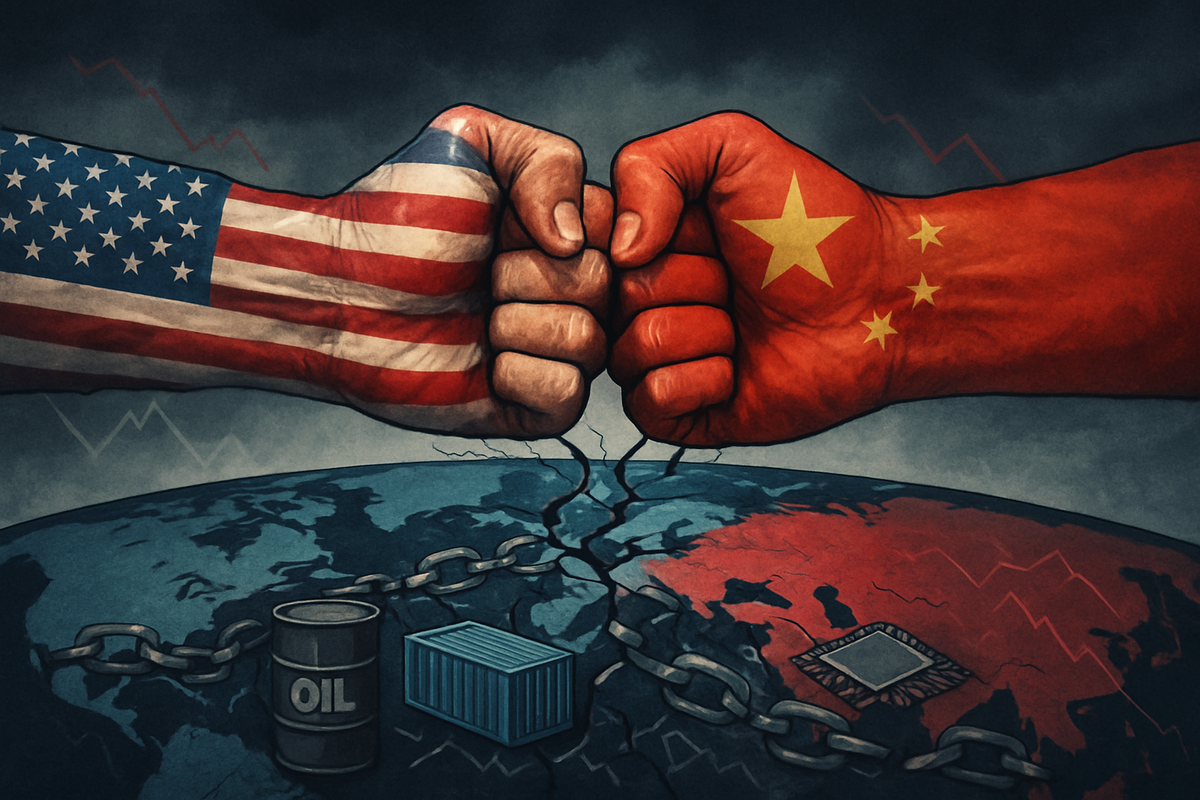
Washington D.C., October 23, 2025 – Global financial markets are reeling from a dramatic escalation in US-China trade tensions, as the Trump administration, in a hypothetical second term, has unleashed a barrage of new tariffs, threatening to reshape global supply chains and ignite widespread inflationary pressures. The latest move, an additional 100% tariff on Chinese goods effective November 1st, has sent shockwaves across commodity markets, fueling fears of a potential market crash and prompting immediate sell-offs in major US stock indices. This aggressive stance marks a significant intensification of the "America First" agenda, prioritizing domestic manufacturing and national security over established global trade norms.
The sweeping tariffs, which in some cases now bring the total duty on Chinese imports to as high as 155%, are poised to significantly increase the cost of goods for American consumers and businesses. The retaliatory measures from Beijing, including expanded export controls on critical minerals, underscore a deepening economic chasm between the world's two largest economies. Investors, consumers, and industries alike are grappling with unprecedented uncertainty, as the prospect of a prolonged and intensifying trade war becomes a stark reality.
A New Era of Economic Nationalism: Unpacking the Latest Tariff Blitz
The current wave of trade hostilities represents a substantial intensification of the US-China economic rivalry, building upon a contentious history. Following President Trump's hypothetical inauguration in January 2025, his administration swiftly moved to implement campaign promises of aggressive trade protectionism. The year began with a 10% tariff on Chinese goods, citing fentanyl trafficking concerns, which quickly escalated to 20% by March. A pivotal moment arrived on April 2, 2025, dubbed "Liberation Day," when the administration declared a national emergency regarding the trade deficit, imposing a minimum 10% tariff on almost all US imports and an additional 34% on Chinese goods, bringing the total to 54%.
This aggressive posture triggered a tit-for-tat spiral, pushing US tariffs on Chinese goods to 145% and Chinese tariffs on US goods to 125% by mid-April. A brief 90-day tariff truce in May offered temporary respite, reducing reciprocal tariffs to 30% for Chinese imports and 10% for American goods. However, the truce expired on August 12, 2025, setting the stage for renewed escalation. The latest and most impactful announcement came on October 10, 2025, when President Trump declared an additional 100% tariff on Chinese goods, effective November 1st, explicitly in response to China's expanded export controls on rare earths. This move pushed the total tariff rate on many Chinese products to 140% or even 155%, with further signals of export controls on "any and all critical software."
Key players in this unfolding drama include the US administration, driven by a mandate to reduce the trade deficit and bolster domestic industries, and the Chinese government, which has consistently responded with matching tariffs and its own strategic export controls, notably on vital rare earth materials, gallium, germanium, and antimony. These minerals are crucial for US tech and defense sectors. The initial market reactions have been immediate and severe: major US stock indices, including the Dow Jones Industrial Average (NYSE: ^DJI), S&P 500 (NYSE: ^GSPC), and Nasdaq Composite (NASDAQ: ^IXIC), have experienced significant sell-offs, reflecting widespread investor apprehension. Analysts universally predict that these tariffs will translate into substantially higher costs for American consumers across a wide array of products, from electronics to automotive components, fueling broader inflationary pressures.
Winners and Losers: A Reshaping of Corporate Fortunes
The escalating trade war is creating a clear divide between potential corporate winners and losers, forcing companies to fundamentally reassess their global supply chains and market strategies.
On the losing side are overwhelmingly multinational corporations heavily reliant on Chinese manufacturing and supply chains. Companies in sectors such as consumer electronics, automotive parts, textiles, and machinery face immediate and substantial increases in their import costs. This directly impacts their profitability and competitiveness. For instance, major tech companies that rely on components manufactured in China will see their input costs surge, potentially eroding margins or necessitating price increases for end consumers. US agricultural exporters, who previously bore the brunt of Chinese retaliatory tariffs, are once again vulnerable to reduced market access as Beijing continues its "Dual Circulation" strategy to strengthen domestic resilience and reduce reliance on external trade.
Conversely, some domestic US industries and companies stand to gain, at least in theory, from increased protection. American manufacturers in sectors like steel and aluminum, which have historically faced competition from cheaper Chinese imports, could see a boost in demand and pricing power. Companies that have already begun diversifying their supply chains away from China or are engaged in reshoring or nearshoring initiatives might find themselves in a more resilient position. For example, firms that have invested in manufacturing capabilities in other Southeast Asian countries or domestically may experience a competitive advantage. However, even these potential "winners" face challenges, including higher raw material costs if tariffs impact global commodity prices, and the broader economic slowdown that a prolonged trade war could trigger. The overall market uncertainty is a negative for almost all businesses.
The technology sector, in particular, faces a complex landscape. While the US aims to restrict China's access to advanced semiconductors and AI hardware, companies like Nvidia (NASDAQ: NVDA) have already seen restrictions on their high-end chip exports to China. China's retaliation with export controls on rare earth materials, vital for magnets in electric vehicles, wind turbines, and defense systems, creates a significant vulnerability for US manufacturers across multiple industries. This tit-for-tat in critical technologies forces companies to seek alternative, often more expensive, sources or invest heavily in domestic extraction and processing capabilities, adding further cost and complexity.
Wider Significance: De-globalization and Geopolitical Realignment
The current trade escalation is more than just a dispute over tariffs; it represents a significant acceleration of de-globalization trends and a fundamental realignment of geopolitical and economic power. This event fits squarely into a broader narrative of strategic competition between the US and China, encompassing not just trade but also technology, national security, and global influence. The emphasis on "America First" policies and the aggressive use of tariffs signal a shift away from multilateral trade agreements towards a more bilateral and protectionist approach.
The ripple effects of these tariffs extend far beyond the US and China. Third-party countries and international economic bodies are deeply concerned about the fragmentation of the global economy. The European Union, for instance, while offering mutual tariff reductions, has also warned of retaliation, planning to reinstate suspended tariffs on steel and aluminum and impose duties on politically sensitive US exports. This creates a risk of a cascading global trade war, where multiple blocs engage in protectionist measures, further disrupting international commerce and supply chains. The World Trade Organization (WTO), already strained by previous trade disputes, faces increased irrelevance as major powers bypass its dispute resolution mechanisms.
Regulatory and policy implications are profound. The US administration's invocation of the International Emergency Economic Powers Act (IEEPA) to implement tariffs bypasses traditional congressional oversight, demonstrating an executive branch willing to wield broad powers in trade policy. China's response, including its "unreliable entity list" and expanded export controls, signifies a strategic pivot towards self-reliance ("Dual Circulation") and a willingness to use its leverage in critical raw materials. Historically, trade wars have rarely produced clear winners, often leading to higher costs for consumers, reduced economic growth, and increased political tensions, as evidenced by the Smoot-Hawley Tariff Act of 1930 and its role in exacerbating the Great Depression. The current situation, however, is unique in its scale and the strategic importance of the technologies and commodities involved, hinting at a more profound and lasting impact on the global economic order.
What Comes Next: A Path Paved with Uncertainty
The immediate future promises continued volatility and uncertainty for global commodity markets and businesses alike. In the short term, companies will scramble to absorb the increased tariff costs, potentially passing them on to consumers, further fueling inflation. Supply chain disruptions are inevitable as firms attempt to re-route or re-source components and finished goods, a process that is both costly and time-consuming. Commodity prices, particularly for those impacted by Chinese demand or export controls (like rare earths and certain industrial metals), will likely see significant fluctuations.
Looking further ahead, the long-term possibilities point towards an accelerated decoupling of the US and Chinese economies, particularly in strategic sectors like technology. This could lead to the emergence of distinct technological ecosystems and supply chains, potentially increasing global production costs and reducing efficiency. Companies will be forced into strategic pivots, including significant investments in diversifying their manufacturing bases to countries outside of China (e.g., Vietnam, India, Mexico) or even reshoring production to their home countries. This shift represents both a challenge and an opportunity: new market opportunities may emerge in regions benefiting from supply chain relocation, while companies failing to adapt will face existential threats.
Potential scenarios range from a prolonged and intensifying trade war, where tariffs become a permanent feature of US-China trade, to periods of managed rivalry with occasional de-escalation, but no return to the pre-2018 status quo. A full-blown global trade war involving other major economies remains a significant risk. For investors, the landscape demands heightened vigilance, as geopolitical developments will increasingly dictate market movements and corporate performance. The emphasis on national security in trade policy suggests that these tensions are unlikely to abate quickly, requiring a long-term strategic outlook from all stakeholders.
Wrap-Up: Navigating a Fractured Global Economy
The escalating US-China trade tensions, underscored by President Trump's aggressive tariff policies in late 2025, represent a watershed moment for the global economy. The key takeaways are clear: a renewed commitment to economic nationalism in the US, a deepening strategic rivalry with China, and significant disruption to established global trade patterns. The market moving forward will be characterized by heightened uncertainty, inflationary pressures, and a fundamental restructuring of global supply chains.
The lasting impact of these events will likely be a more fractured global economy, where trade policy is increasingly intertwined with national security and geopolitical objectives. Companies will prioritize resilience and diversification over pure cost efficiency, leading to higher production costs but potentially more secure supply chains. This era demands a new playbook from businesses and investors alike.
Investors should closely watch several key indicators in the coming months: further government policy announcements from both the US and China, especially regarding export controls and retaliatory measures; company earnings reports for insights into the impact of tariffs on profitability and supply chain adjustments; and movements in critical commodity prices, particularly those affected by trade restrictions. Geopolitical developments, including any shifts in alliances or international trade agreements, will also be crucial for understanding the evolving landscape. The path ahead is fraught with challenges, but also holds the potential for new opportunities for those who can adapt to a rapidly changing global economic order.
This content is intended for informational purposes only and is not financial advice






